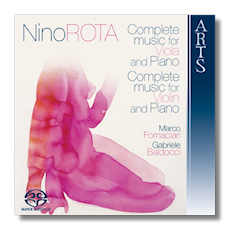
The Internet's Premier Classical Music Source
Related Links
- Rota Reviews
- Latest Reviews
- More Reviews
-
By Composer
-
Collections
DVD & Blu-ray
Books
Concert Reviews
Articles/Interviews
Software
Audio
Search Amazon
Recommended Links
Site News
 SACD Review
SACD Review
Nino Rota

Complete Music for Viola/Violin & Piano
- Intermezzo in B minor for Viola & Piano
- Sonata in C Major for Viola & Piano
- Sonata in G Major for Viola & Piano
- Sonata in G Major for Violin & Piano
- Improvviso for Violin & Piano "Un Diavolo Sentimentale"
- Improvviso for Violin & Piano "Amanti Senza Amore"
Marco Fornaciari, viola & violin
Garbriele Baldocci, piano
Arts 47718-8 Hybrid Multichannel SACD DDD 65:03
Famous primarily for his film scores (Franco Zeffirelli's Roméo and Juliet, The Godfather films, several films directed by Federico Fellini), Nino Rota (1911-1979) nevertheless had a rich and distinguished career as a composer of concert music. This CD contains what is advertised as his complete music for viola and piano, and his complete music for violin and piano. The earliest of these works is the Viola Sonata in G, which was composed in 1934-35, and the most recent is the Improvviso, "Un Diavolo Sentimentale," which was composed in 1969.
Rota had the capacity to write in many different styles – a useful skill for a film composer. Nevertheless, he was not simply an imitator, and even though his music is stylistically heterogeneous, Rota's distinctive voice remains constant throughout his work. The six works on this CD are proudly tonal, and they pay more of a debt to the Romantic era than to Rota's contemporaries. Paradoxically, though, while hearing these works, it is another 20th-century composer who comes most frequently to mind, and that is Samuel Barber, whose plain-spoken yet rich melodies might be kissing cousins to Rota's. In his booklet notes to this release, pianist Baldocci rightly suggests the influence of impressionism on the two G-major sonatas, but it would be easy to overstate that case. Rota's teacher Casella also makes his presence felt.
Rota's connection with the cinema is not entirely ignored on this CD, however, because "Amanti senza amore" was a film dating from 1947 for which Rota composed the score. (The English title was "Prelude to Madness," and to complicate matters further, the script was based on Tolstoy's The Kreutzer Sonata.) The short Improvviso was composed specifically for the film.
These works are not new to CD, but this appears to be the only CD currently available to bring all of them together. (A Dynamic release featuring Luigi Alberto Bianchi and pianist Mario Vincenzi seems to be out of print, and anyway, it omits "Amanti senza amore.") The performances are mellow; Fornaciari in particular sounds as if he has been bathing in Chianti for some time. The sound of his viola is gorgeous, however. (I am less impressed with the violin, which sounds a little thin on this CD.) Baldocci discharges his duties with aplomb and no lack of commitment. There is a good sense of communication between Fornaciari and Baldocci. In the end, one might wish for playing that has a little more flash to it, but the present performers definitely leave you feeling good when the CD has come to an end. Arts' engineering is atmospheric, capturing both the sound of the instruments and the hall in which they are being played.
Copyright © 2008, Raymond Tuttle




















